Employee Dissatisfaction at The Home Makers: Causes and Solutions
VerifiedAdded on 2023/06/15
|10
|3458
|387
Report
AI Summary
This report investigates the causes and consequences of employee dissatisfaction at 'The Home Makers,' a fictitious company producing plastic lunch boxes. The report identifies issues such as unequal pay distribution, poor management, lack of rewards and recognition, limited career growth, poor work-life balance, and ineffective change management. Consequences include decreased employee performance, high employee turnover, a damaged company image, and financial losses. The report recommends implementing an effective change management process, introducing a rewards and recognition program, improving HR and recruitment practices to improve employee satisfaction. Desklib provides access to this and many other solved assignments.
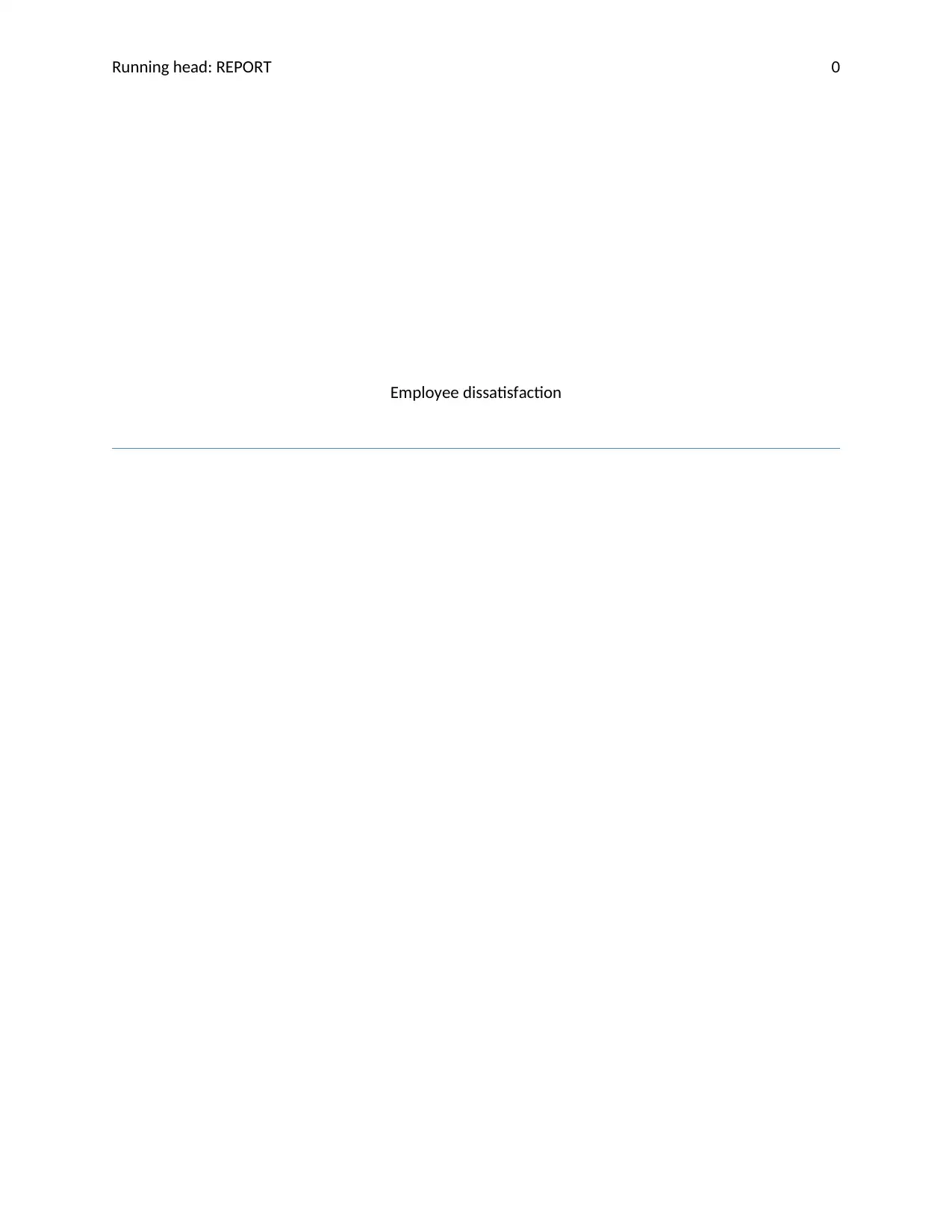
Running head: REPORT 0
Employee dissatisfaction
Employee dissatisfaction
Paraphrase This Document
Need a fresh take? Get an instant paraphrase of this document with our AI Paraphraser
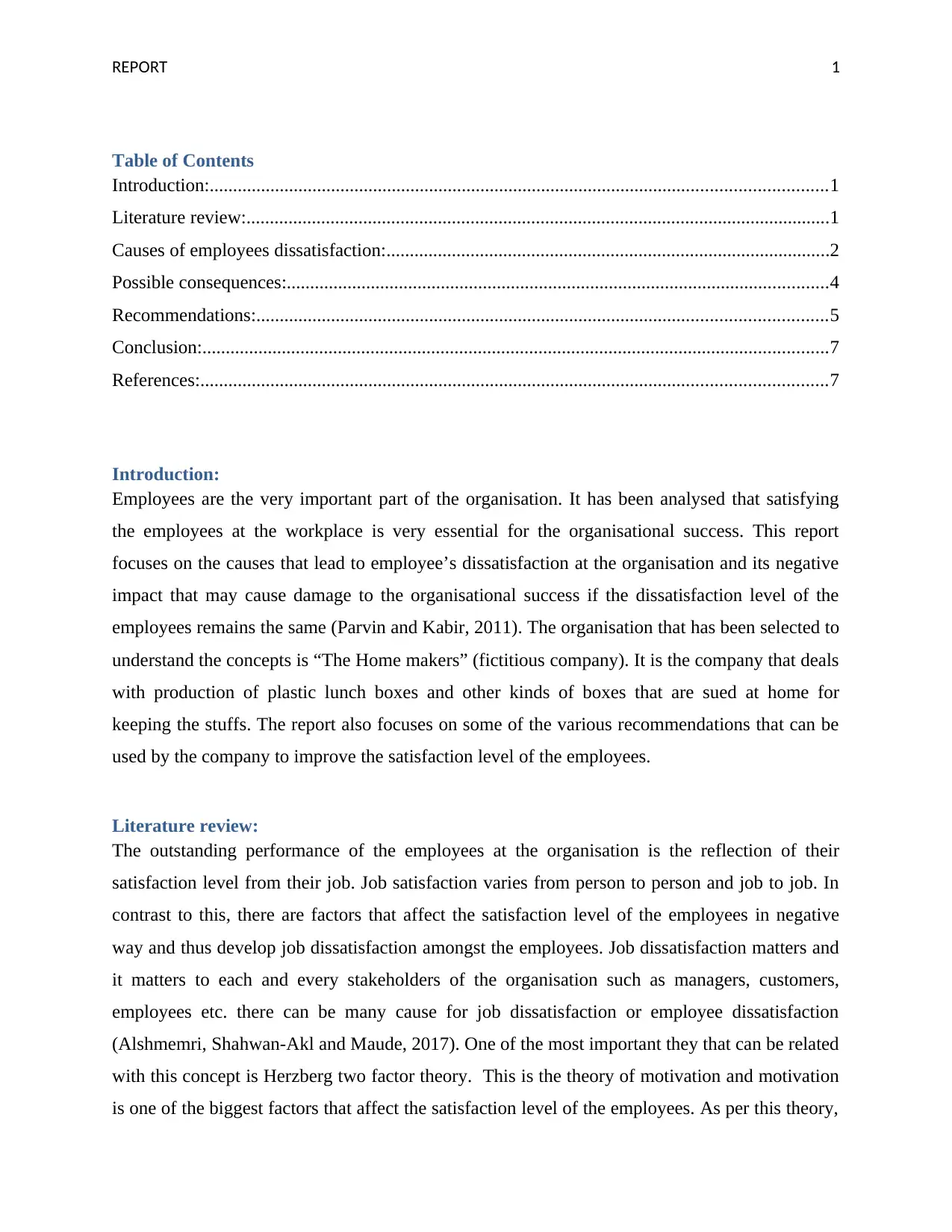
REPORT 1
Table of Contents
Introduction:....................................................................................................................................1
Literature review:.............................................................................................................................1
Causes of employees dissatisfaction:...............................................................................................2
Possible consequences:....................................................................................................................4
Recommendations:..........................................................................................................................5
Conclusion:......................................................................................................................................7
References:......................................................................................................................................7
Introduction:
Employees are the very important part of the organisation. It has been analysed that satisfying
the employees at the workplace is very essential for the organisational success. This report
focuses on the causes that lead to employee’s dissatisfaction at the organisation and its negative
impact that may cause damage to the organisational success if the dissatisfaction level of the
employees remains the same (Parvin and Kabir, 2011). The organisation that has been selected to
understand the concepts is “The Home makers” (fictitious company). It is the company that deals
with production of plastic lunch boxes and other kinds of boxes that are sued at home for
keeping the stuffs. The report also focuses on some of the various recommendations that can be
used by the company to improve the satisfaction level of the employees.
Literature review:
The outstanding performance of the employees at the organisation is the reflection of their
satisfaction level from their job. Job satisfaction varies from person to person and job to job. In
contrast to this, there are factors that affect the satisfaction level of the employees in negative
way and thus develop job dissatisfaction amongst the employees. Job dissatisfaction matters and
it matters to each and every stakeholders of the organisation such as managers, customers,
employees etc. there can be many cause for job dissatisfaction or employee dissatisfaction
(Alshmemri, Shahwan-Akl and Maude, 2017). One of the most important they that can be related
with this concept is Herzberg two factor theory. This is the theory of motivation and motivation
is one of the biggest factors that affect the satisfaction level of the employees. As per this theory,
Table of Contents
Introduction:....................................................................................................................................1
Literature review:.............................................................................................................................1
Causes of employees dissatisfaction:...............................................................................................2
Possible consequences:....................................................................................................................4
Recommendations:..........................................................................................................................5
Conclusion:......................................................................................................................................7
References:......................................................................................................................................7
Introduction:
Employees are the very important part of the organisation. It has been analysed that satisfying
the employees at the workplace is very essential for the organisational success. This report
focuses on the causes that lead to employee’s dissatisfaction at the organisation and its negative
impact that may cause damage to the organisational success if the dissatisfaction level of the
employees remains the same (Parvin and Kabir, 2011). The organisation that has been selected to
understand the concepts is “The Home makers” (fictitious company). It is the company that deals
with production of plastic lunch boxes and other kinds of boxes that are sued at home for
keeping the stuffs. The report also focuses on some of the various recommendations that can be
used by the company to improve the satisfaction level of the employees.
Literature review:
The outstanding performance of the employees at the organisation is the reflection of their
satisfaction level from their job. Job satisfaction varies from person to person and job to job. In
contrast to this, there are factors that affect the satisfaction level of the employees in negative
way and thus develop job dissatisfaction amongst the employees. Job dissatisfaction matters and
it matters to each and every stakeholders of the organisation such as managers, customers,
employees etc. there can be many cause for job dissatisfaction or employee dissatisfaction
(Alshmemri, Shahwan-Akl and Maude, 2017). One of the most important they that can be related
with this concept is Herzberg two factor theory. This is the theory of motivation and motivation
is one of the biggest factors that affect the satisfaction level of the employees. As per this theory,
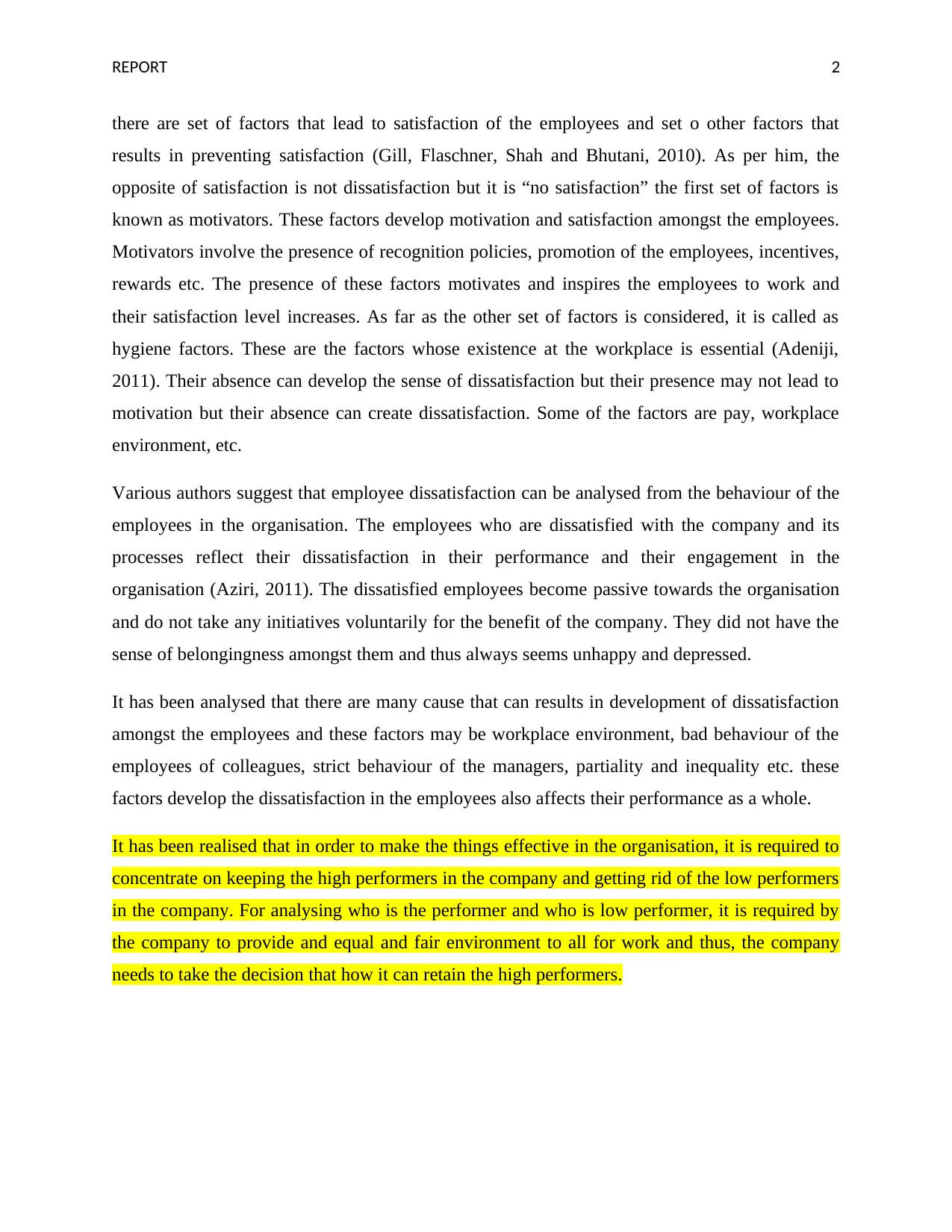
REPORT 2
there are set of factors that lead to satisfaction of the employees and set o other factors that
results in preventing satisfaction (Gill, Flaschner, Shah and Bhutani, 2010). As per him, the
opposite of satisfaction is not dissatisfaction but it is “no satisfaction” the first set of factors is
known as motivators. These factors develop motivation and satisfaction amongst the employees.
Motivators involve the presence of recognition policies, promotion of the employees, incentives,
rewards etc. The presence of these factors motivates and inspires the employees to work and
their satisfaction level increases. As far as the other set of factors is considered, it is called as
hygiene factors. These are the factors whose existence at the workplace is essential (Adeniji,
2011). Their absence can develop the sense of dissatisfaction but their presence may not lead to
motivation but their absence can create dissatisfaction. Some of the factors are pay, workplace
environment, etc.
Various authors suggest that employee dissatisfaction can be analysed from the behaviour of the
employees in the organisation. The employees who are dissatisfied with the company and its
processes reflect their dissatisfaction in their performance and their engagement in the
organisation (Aziri, 2011). The dissatisfied employees become passive towards the organisation
and do not take any initiatives voluntarily for the benefit of the company. They did not have the
sense of belongingness amongst them and thus always seems unhappy and depressed.
It has been analysed that there are many cause that can results in development of dissatisfaction
amongst the employees and these factors may be workplace environment, bad behaviour of the
employees of colleagues, strict behaviour of the managers, partiality and inequality etc. these
factors develop the dissatisfaction in the employees also affects their performance as a whole.
It has been realised that in order to make the things effective in the organisation, it is required to
concentrate on keeping the high performers in the company and getting rid of the low performers
in the company. For analysing who is the performer and who is low performer, it is required by
the company to provide and equal and fair environment to all for work and thus, the company
needs to take the decision that how it can retain the high performers.
there are set of factors that lead to satisfaction of the employees and set o other factors that
results in preventing satisfaction (Gill, Flaschner, Shah and Bhutani, 2010). As per him, the
opposite of satisfaction is not dissatisfaction but it is “no satisfaction” the first set of factors is
known as motivators. These factors develop motivation and satisfaction amongst the employees.
Motivators involve the presence of recognition policies, promotion of the employees, incentives,
rewards etc. The presence of these factors motivates and inspires the employees to work and
their satisfaction level increases. As far as the other set of factors is considered, it is called as
hygiene factors. These are the factors whose existence at the workplace is essential (Adeniji,
2011). Their absence can develop the sense of dissatisfaction but their presence may not lead to
motivation but their absence can create dissatisfaction. Some of the factors are pay, workplace
environment, etc.
Various authors suggest that employee dissatisfaction can be analysed from the behaviour of the
employees in the organisation. The employees who are dissatisfied with the company and its
processes reflect their dissatisfaction in their performance and their engagement in the
organisation (Aziri, 2011). The dissatisfied employees become passive towards the organisation
and do not take any initiatives voluntarily for the benefit of the company. They did not have the
sense of belongingness amongst them and thus always seems unhappy and depressed.
It has been analysed that there are many cause that can results in development of dissatisfaction
amongst the employees and these factors may be workplace environment, bad behaviour of the
employees of colleagues, strict behaviour of the managers, partiality and inequality etc. these
factors develop the dissatisfaction in the employees also affects their performance as a whole.
It has been realised that in order to make the things effective in the organisation, it is required to
concentrate on keeping the high performers in the company and getting rid of the low performers
in the company. For analysing who is the performer and who is low performer, it is required by
the company to provide and equal and fair environment to all for work and thus, the company
needs to take the decision that how it can retain the high performers.
⊘ This is a preview!⊘
Do you want full access?
Subscribe today to unlock all pages.

Trusted by 1+ million students worldwide
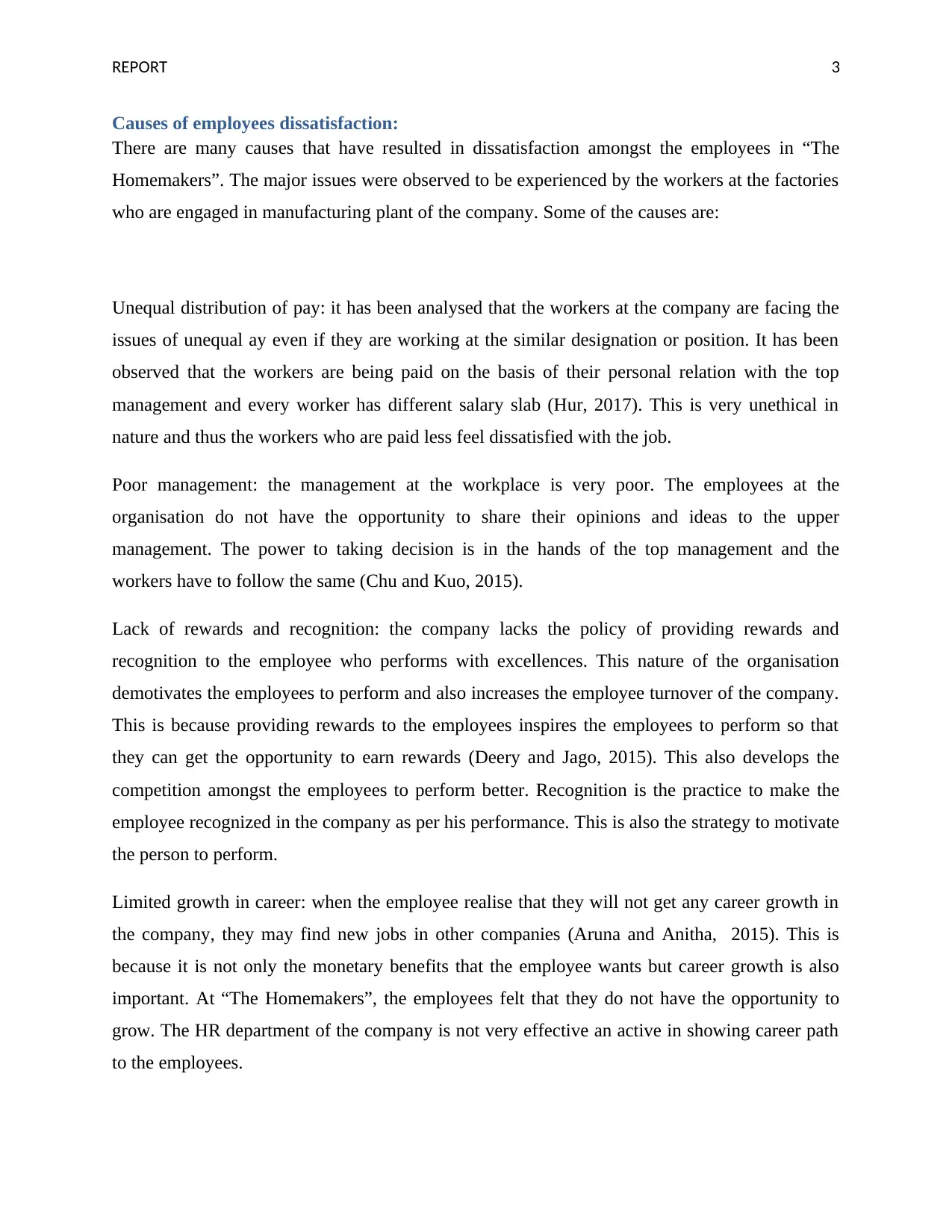
REPORT 3
Causes of employees dissatisfaction:
There are many causes that have resulted in dissatisfaction amongst the employees in “The
Homemakers”. The major issues were observed to be experienced by the workers at the factories
who are engaged in manufacturing plant of the company. Some of the causes are:
Unequal distribution of pay: it has been analysed that the workers at the company are facing the
issues of unequal ay even if they are working at the similar designation or position. It has been
observed that the workers are being paid on the basis of their personal relation with the top
management and every worker has different salary slab (Hur, 2017). This is very unethical in
nature and thus the workers who are paid less feel dissatisfied with the job.
Poor management: the management at the workplace is very poor. The employees at the
organisation do not have the opportunity to share their opinions and ideas to the upper
management. The power to taking decision is in the hands of the top management and the
workers have to follow the same (Chu and Kuo, 2015).
Lack of rewards and recognition: the company lacks the policy of providing rewards and
recognition to the employee who performs with excellences. This nature of the organisation
demotivates the employees to perform and also increases the employee turnover of the company.
This is because providing rewards to the employees inspires the employees to perform so that
they can get the opportunity to earn rewards (Deery and Jago, 2015). This also develops the
competition amongst the employees to perform better. Recognition is the practice to make the
employee recognized in the company as per his performance. This is also the strategy to motivate
the person to perform.
Limited growth in career: when the employee realise that they will not get any career growth in
the company, they may find new jobs in other companies (Aruna and Anitha, 2015). This is
because it is not only the monetary benefits that the employee wants but career growth is also
important. At “The Homemakers”, the employees felt that they do not have the opportunity to
grow. The HR department of the company is not very effective an active in showing career path
to the employees.
Causes of employees dissatisfaction:
There are many causes that have resulted in dissatisfaction amongst the employees in “The
Homemakers”. The major issues were observed to be experienced by the workers at the factories
who are engaged in manufacturing plant of the company. Some of the causes are:
Unequal distribution of pay: it has been analysed that the workers at the company are facing the
issues of unequal ay even if they are working at the similar designation or position. It has been
observed that the workers are being paid on the basis of their personal relation with the top
management and every worker has different salary slab (Hur, 2017). This is very unethical in
nature and thus the workers who are paid less feel dissatisfied with the job.
Poor management: the management at the workplace is very poor. The employees at the
organisation do not have the opportunity to share their opinions and ideas to the upper
management. The power to taking decision is in the hands of the top management and the
workers have to follow the same (Chu and Kuo, 2015).
Lack of rewards and recognition: the company lacks the policy of providing rewards and
recognition to the employee who performs with excellences. This nature of the organisation
demotivates the employees to perform and also increases the employee turnover of the company.
This is because providing rewards to the employees inspires the employees to perform so that
they can get the opportunity to earn rewards (Deery and Jago, 2015). This also develops the
competition amongst the employees to perform better. Recognition is the practice to make the
employee recognized in the company as per his performance. This is also the strategy to motivate
the person to perform.
Limited growth in career: when the employee realise that they will not get any career growth in
the company, they may find new jobs in other companies (Aruna and Anitha, 2015). This is
because it is not only the monetary benefits that the employee wants but career growth is also
important. At “The Homemakers”, the employees felt that they do not have the opportunity to
grow. The HR department of the company is not very effective an active in showing career path
to the employees.
Paraphrase This Document
Need a fresh take? Get an instant paraphrase of this document with our AI Paraphraser
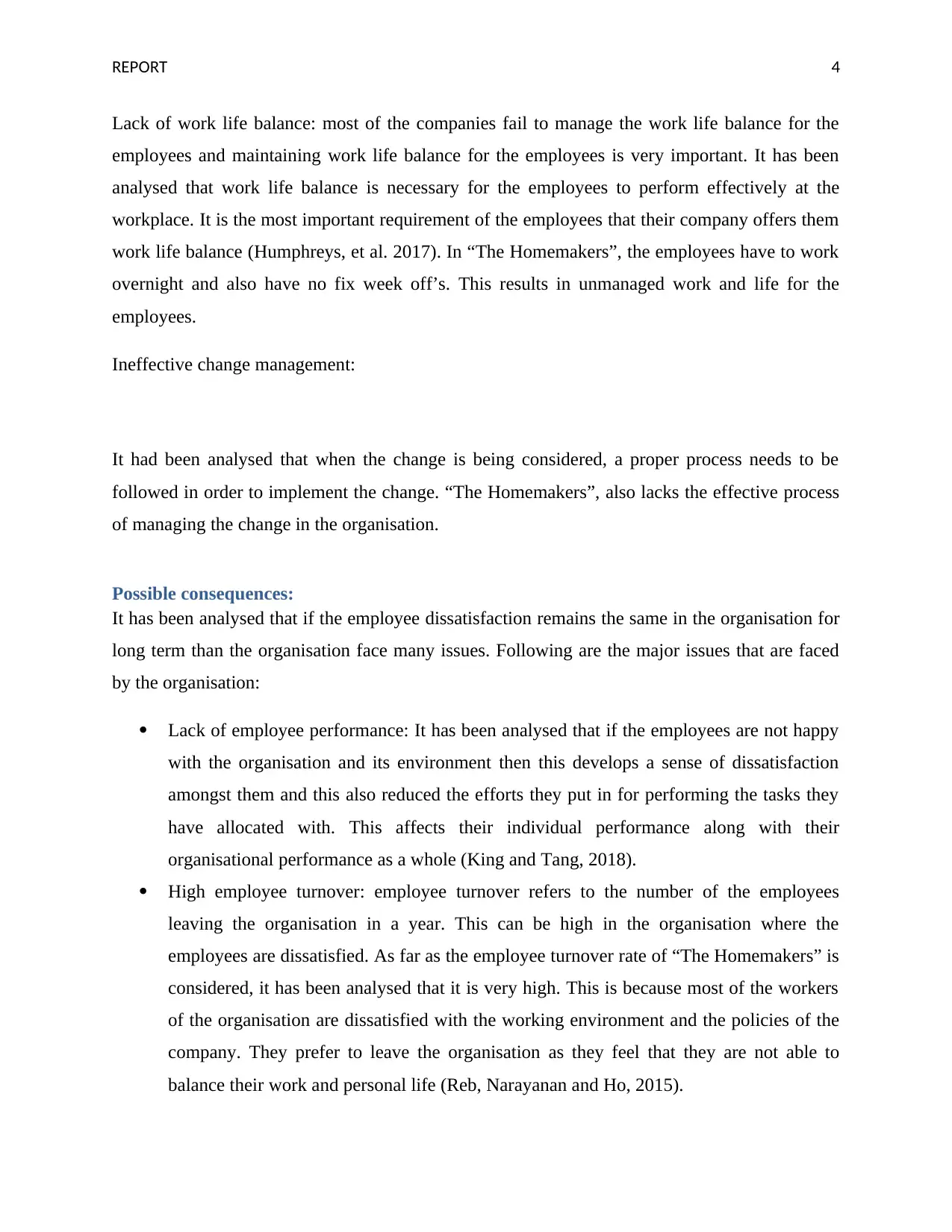
REPORT 4
Lack of work life balance: most of the companies fail to manage the work life balance for the
employees and maintaining work life balance for the employees is very important. It has been
analysed that work life balance is necessary for the employees to perform effectively at the
workplace. It is the most important requirement of the employees that their company offers them
work life balance (Humphreys, et al. 2017). In “The Homemakers”, the employees have to work
overnight and also have no fix week off’s. This results in unmanaged work and life for the
employees.
Ineffective change management:
It had been analysed that when the change is being considered, a proper process needs to be
followed in order to implement the change. “The Homemakers”, also lacks the effective process
of managing the change in the organisation.
Possible consequences:
It has been analysed that if the employee dissatisfaction remains the same in the organisation for
long term than the organisation face many issues. Following are the major issues that are faced
by the organisation:
Lack of employee performance: It has been analysed that if the employees are not happy
with the organisation and its environment then this develops a sense of dissatisfaction
amongst them and this also reduced the efforts they put in for performing the tasks they
have allocated with. This affects their individual performance along with their
organisational performance as a whole (King and Tang, 2018).
High employee turnover: employee turnover refers to the number of the employees
leaving the organisation in a year. This can be high in the organisation where the
employees are dissatisfied. As far as the employee turnover rate of “The Homemakers” is
considered, it has been analysed that it is very high. This is because most of the workers
of the organisation are dissatisfied with the working environment and the policies of the
company. They prefer to leave the organisation as they feel that they are not able to
balance their work and personal life (Reb, Narayanan and Ho, 2015).
Lack of work life balance: most of the companies fail to manage the work life balance for the
employees and maintaining work life balance for the employees is very important. It has been
analysed that work life balance is necessary for the employees to perform effectively at the
workplace. It is the most important requirement of the employees that their company offers them
work life balance (Humphreys, et al. 2017). In “The Homemakers”, the employees have to work
overnight and also have no fix week off’s. This results in unmanaged work and life for the
employees.
Ineffective change management:
It had been analysed that when the change is being considered, a proper process needs to be
followed in order to implement the change. “The Homemakers”, also lacks the effective process
of managing the change in the organisation.
Possible consequences:
It has been analysed that if the employee dissatisfaction remains the same in the organisation for
long term than the organisation face many issues. Following are the major issues that are faced
by the organisation:
Lack of employee performance: It has been analysed that if the employees are not happy
with the organisation and its environment then this develops a sense of dissatisfaction
amongst them and this also reduced the efforts they put in for performing the tasks they
have allocated with. This affects their individual performance along with their
organisational performance as a whole (King and Tang, 2018).
High employee turnover: employee turnover refers to the number of the employees
leaving the organisation in a year. This can be high in the organisation where the
employees are dissatisfied. As far as the employee turnover rate of “The Homemakers” is
considered, it has been analysed that it is very high. This is because most of the workers
of the organisation are dissatisfied with the working environment and the policies of the
company. They prefer to leave the organisation as they feel that they are not able to
balance their work and personal life (Reb, Narayanan and Ho, 2015).
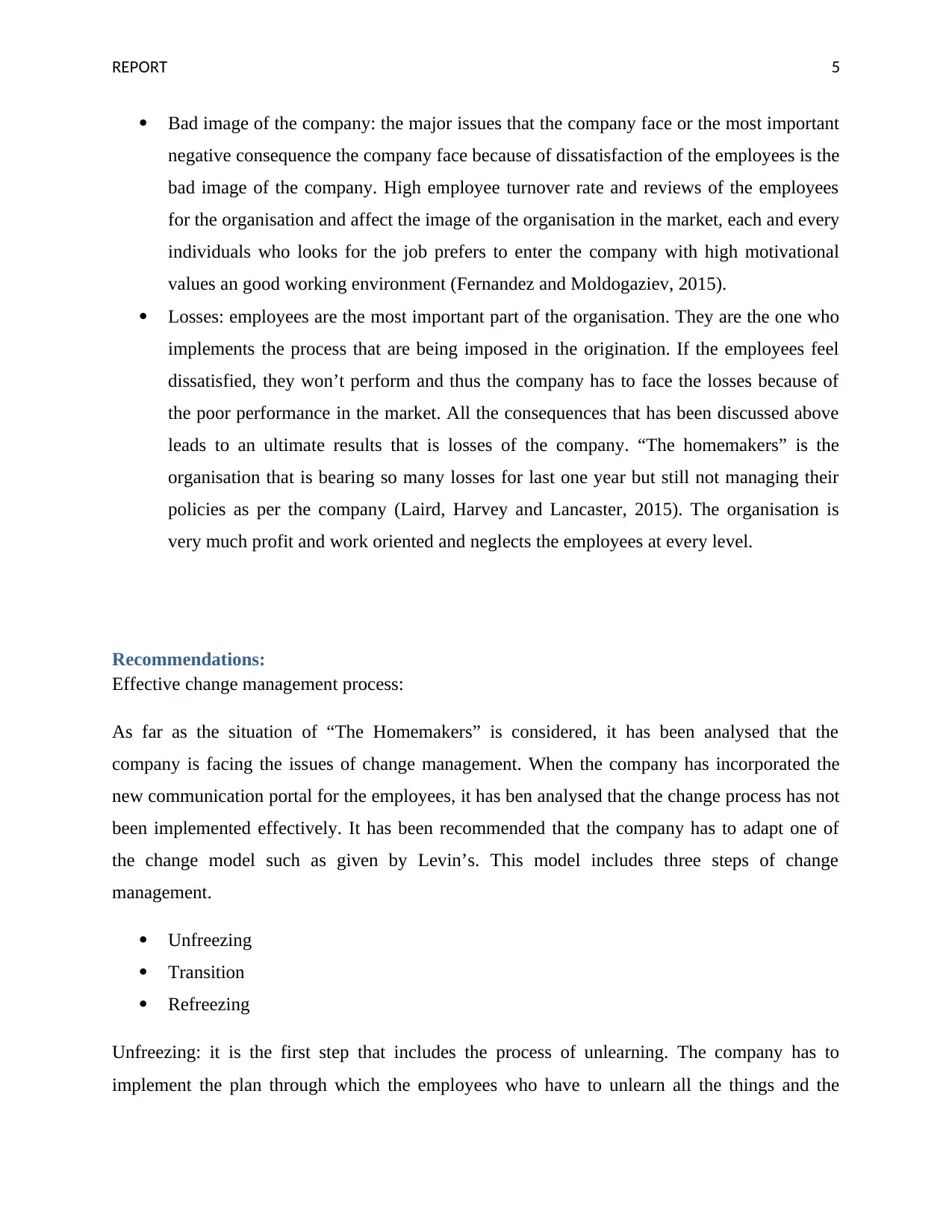
REPORT 5
Bad image of the company: the major issues that the company face or the most important
negative consequence the company face because of dissatisfaction of the employees is the
bad image of the company. High employee turnover rate and reviews of the employees
for the organisation and affect the image of the organisation in the market, each and every
individuals who looks for the job prefers to enter the company with high motivational
values an good working environment (Fernandez and Moldogaziev, 2015).
Losses: employees are the most important part of the organisation. They are the one who
implements the process that are being imposed in the origination. If the employees feel
dissatisfied, they won’t perform and thus the company has to face the losses because of
the poor performance in the market. All the consequences that has been discussed above
leads to an ultimate results that is losses of the company. “The homemakers” is the
organisation that is bearing so many losses for last one year but still not managing their
policies as per the company (Laird, Harvey and Lancaster, 2015). The organisation is
very much profit and work oriented and neglects the employees at every level.
Recommendations:
Effective change management process:
As far as the situation of “The Homemakers” is considered, it has been analysed that the
company is facing the issues of change management. When the company has incorporated the
new communication portal for the employees, it has ben analysed that the change process has not
been implemented effectively. It has been recommended that the company has to adapt one of
the change model such as given by Levin’s. This model includes three steps of change
management.
Unfreezing
Transition
Refreezing
Unfreezing: it is the first step that includes the process of unlearning. The company has to
implement the plan through which the employees who have to unlearn all the things and the
Bad image of the company: the major issues that the company face or the most important
negative consequence the company face because of dissatisfaction of the employees is the
bad image of the company. High employee turnover rate and reviews of the employees
for the organisation and affect the image of the organisation in the market, each and every
individuals who looks for the job prefers to enter the company with high motivational
values an good working environment (Fernandez and Moldogaziev, 2015).
Losses: employees are the most important part of the organisation. They are the one who
implements the process that are being imposed in the origination. If the employees feel
dissatisfied, they won’t perform and thus the company has to face the losses because of
the poor performance in the market. All the consequences that has been discussed above
leads to an ultimate results that is losses of the company. “The homemakers” is the
organisation that is bearing so many losses for last one year but still not managing their
policies as per the company (Laird, Harvey and Lancaster, 2015). The organisation is
very much profit and work oriented and neglects the employees at every level.
Recommendations:
Effective change management process:
As far as the situation of “The Homemakers” is considered, it has been analysed that the
company is facing the issues of change management. When the company has incorporated the
new communication portal for the employees, it has ben analysed that the change process has not
been implemented effectively. It has been recommended that the company has to adapt one of
the change model such as given by Levin’s. This model includes three steps of change
management.
Unfreezing
Transition
Refreezing
Unfreezing: it is the first step that includes the process of unlearning. The company has to
implement the plan through which the employees who have to unlearn all the things and the
⊘ This is a preview!⊘
Do you want full access?
Subscribe today to unlock all pages.

Trusted by 1+ million students worldwide
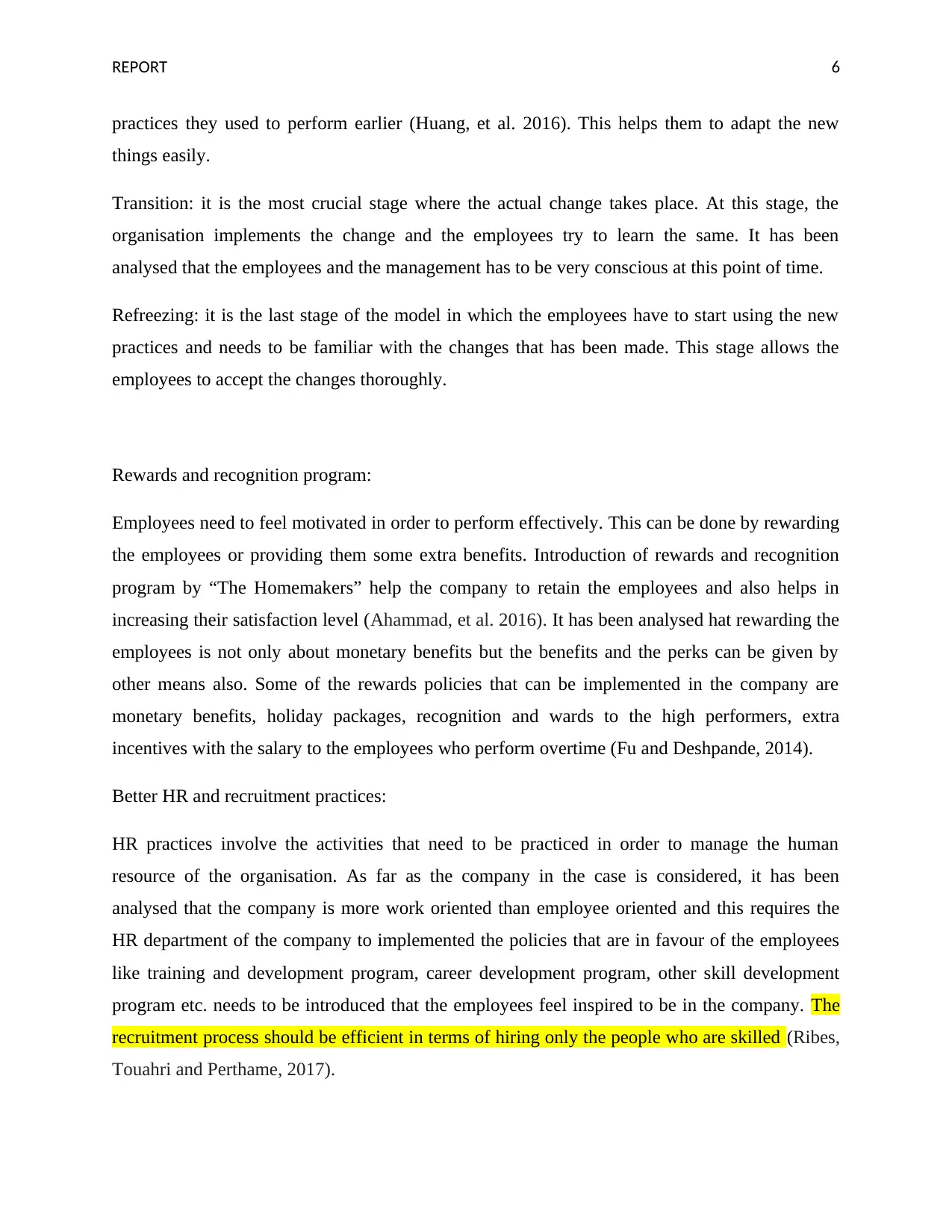
REPORT 6
practices they used to perform earlier (Huang, et al. 2016). This helps them to adapt the new
things easily.
Transition: it is the most crucial stage where the actual change takes place. At this stage, the
organisation implements the change and the employees try to learn the same. It has been
analysed that the employees and the management has to be very conscious at this point of time.
Refreezing: it is the last stage of the model in which the employees have to start using the new
practices and needs to be familiar with the changes that has been made. This stage allows the
employees to accept the changes thoroughly.
Rewards and recognition program:
Employees need to feel motivated in order to perform effectively. This can be done by rewarding
the employees or providing them some extra benefits. Introduction of rewards and recognition
program by “The Homemakers” help the company to retain the employees and also helps in
increasing their satisfaction level (Ahammad, et al. 2016). It has been analysed hat rewarding the
employees is not only about monetary benefits but the benefits and the perks can be given by
other means also. Some of the rewards policies that can be implemented in the company are
monetary benefits, holiday packages, recognition and wards to the high performers, extra
incentives with the salary to the employees who perform overtime (Fu and Deshpande, 2014).
Better HR and recruitment practices:
HR practices involve the activities that need to be practiced in order to manage the human
resource of the organisation. As far as the company in the case is considered, it has been
analysed that the company is more work oriented than employee oriented and this requires the
HR department of the company to implemented the policies that are in favour of the employees
like training and development program, career development program, other skill development
program etc. needs to be introduced that the employees feel inspired to be in the company. The
recruitment process should be efficient in terms of hiring only the people who are skilled (Ribes,
Touahri and Perthame, 2017).
practices they used to perform earlier (Huang, et al. 2016). This helps them to adapt the new
things easily.
Transition: it is the most crucial stage where the actual change takes place. At this stage, the
organisation implements the change and the employees try to learn the same. It has been
analysed that the employees and the management has to be very conscious at this point of time.
Refreezing: it is the last stage of the model in which the employees have to start using the new
practices and needs to be familiar with the changes that has been made. This stage allows the
employees to accept the changes thoroughly.
Rewards and recognition program:
Employees need to feel motivated in order to perform effectively. This can be done by rewarding
the employees or providing them some extra benefits. Introduction of rewards and recognition
program by “The Homemakers” help the company to retain the employees and also helps in
increasing their satisfaction level (Ahammad, et al. 2016). It has been analysed hat rewarding the
employees is not only about monetary benefits but the benefits and the perks can be given by
other means also. Some of the rewards policies that can be implemented in the company are
monetary benefits, holiday packages, recognition and wards to the high performers, extra
incentives with the salary to the employees who perform overtime (Fu and Deshpande, 2014).
Better HR and recruitment practices:
HR practices involve the activities that need to be practiced in order to manage the human
resource of the organisation. As far as the company in the case is considered, it has been
analysed that the company is more work oriented than employee oriented and this requires the
HR department of the company to implemented the policies that are in favour of the employees
like training and development program, career development program, other skill development
program etc. needs to be introduced that the employees feel inspired to be in the company. The
recruitment process should be efficient in terms of hiring only the people who are skilled (Ribes,
Touahri and Perthame, 2017).
Paraphrase This Document
Need a fresh take? Get an instant paraphrase of this document with our AI Paraphraser
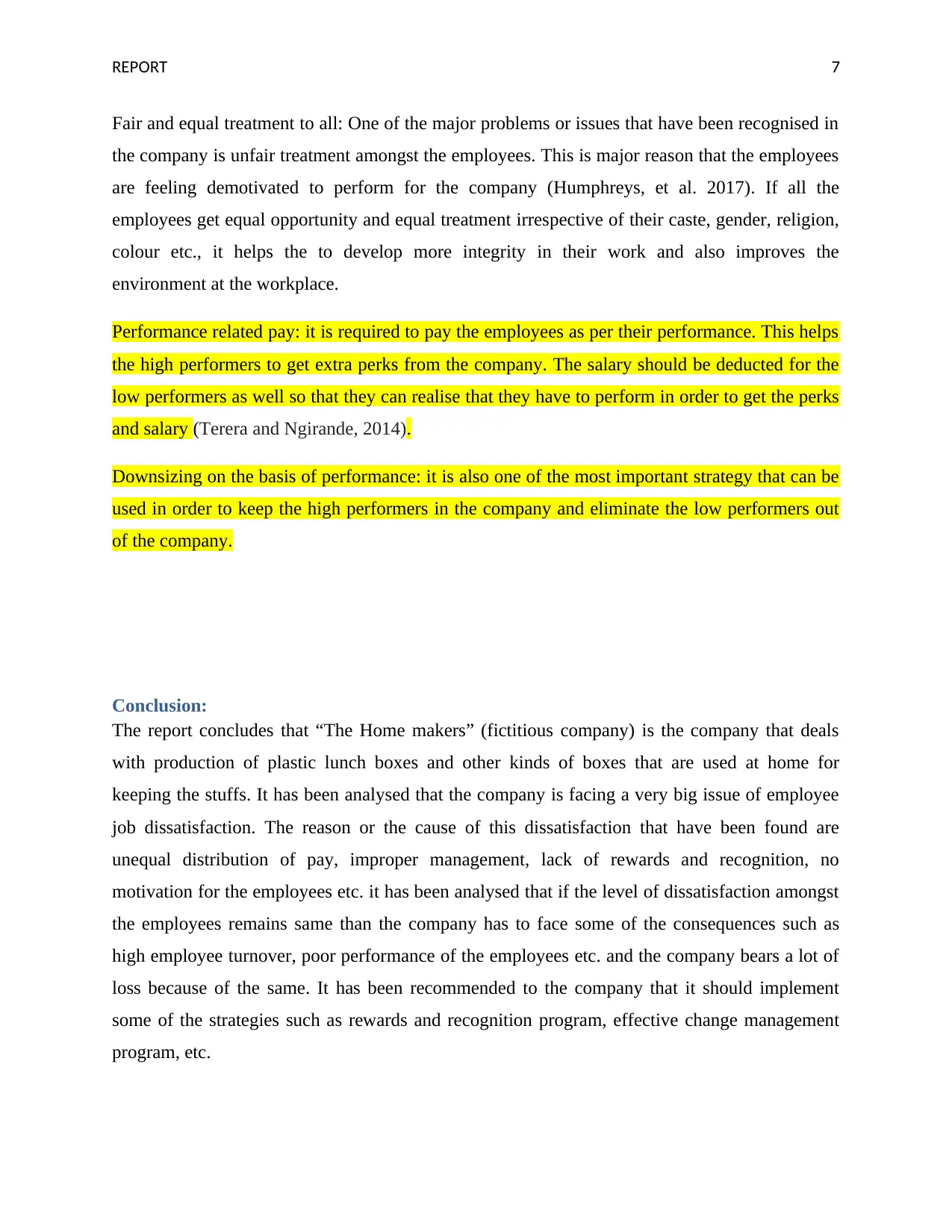
REPORT 7
Fair and equal treatment to all: One of the major problems or issues that have been recognised in
the company is unfair treatment amongst the employees. This is major reason that the employees
are feeling demotivated to perform for the company (Humphreys, et al. 2017). If all the
employees get equal opportunity and equal treatment irrespective of their caste, gender, religion,
colour etc., it helps the to develop more integrity in their work and also improves the
environment at the workplace.
Performance related pay: it is required to pay the employees as per their performance. This helps
the high performers to get extra perks from the company. The salary should be deducted for the
low performers as well so that they can realise that they have to perform in order to get the perks
and salary (Terera and Ngirande, 2014).
Downsizing on the basis of performance: it is also one of the most important strategy that can be
used in order to keep the high performers in the company and eliminate the low performers out
of the company.
Conclusion:
The report concludes that “The Home makers” (fictitious company) is the company that deals
with production of plastic lunch boxes and other kinds of boxes that are used at home for
keeping the stuffs. It has been analysed that the company is facing a very big issue of employee
job dissatisfaction. The reason or the cause of this dissatisfaction that have been found are
unequal distribution of pay, improper management, lack of rewards and recognition, no
motivation for the employees etc. it has been analysed that if the level of dissatisfaction amongst
the employees remains same than the company has to face some of the consequences such as
high employee turnover, poor performance of the employees etc. and the company bears a lot of
loss because of the same. It has been recommended to the company that it should implement
some of the strategies such as rewards and recognition program, effective change management
program, etc.
Fair and equal treatment to all: One of the major problems or issues that have been recognised in
the company is unfair treatment amongst the employees. This is major reason that the employees
are feeling demotivated to perform for the company (Humphreys, et al. 2017). If all the
employees get equal opportunity and equal treatment irrespective of their caste, gender, religion,
colour etc., it helps the to develop more integrity in their work and also improves the
environment at the workplace.
Performance related pay: it is required to pay the employees as per their performance. This helps
the high performers to get extra perks from the company. The salary should be deducted for the
low performers as well so that they can realise that they have to perform in order to get the perks
and salary (Terera and Ngirande, 2014).
Downsizing on the basis of performance: it is also one of the most important strategy that can be
used in order to keep the high performers in the company and eliminate the low performers out
of the company.
Conclusion:
The report concludes that “The Home makers” (fictitious company) is the company that deals
with production of plastic lunch boxes and other kinds of boxes that are used at home for
keeping the stuffs. It has been analysed that the company is facing a very big issue of employee
job dissatisfaction. The reason or the cause of this dissatisfaction that have been found are
unequal distribution of pay, improper management, lack of rewards and recognition, no
motivation for the employees etc. it has been analysed that if the level of dissatisfaction amongst
the employees remains same than the company has to face some of the consequences such as
high employee turnover, poor performance of the employees etc. and the company bears a lot of
loss because of the same. It has been recommended to the company that it should implement
some of the strategies such as rewards and recognition program, effective change management
program, etc.
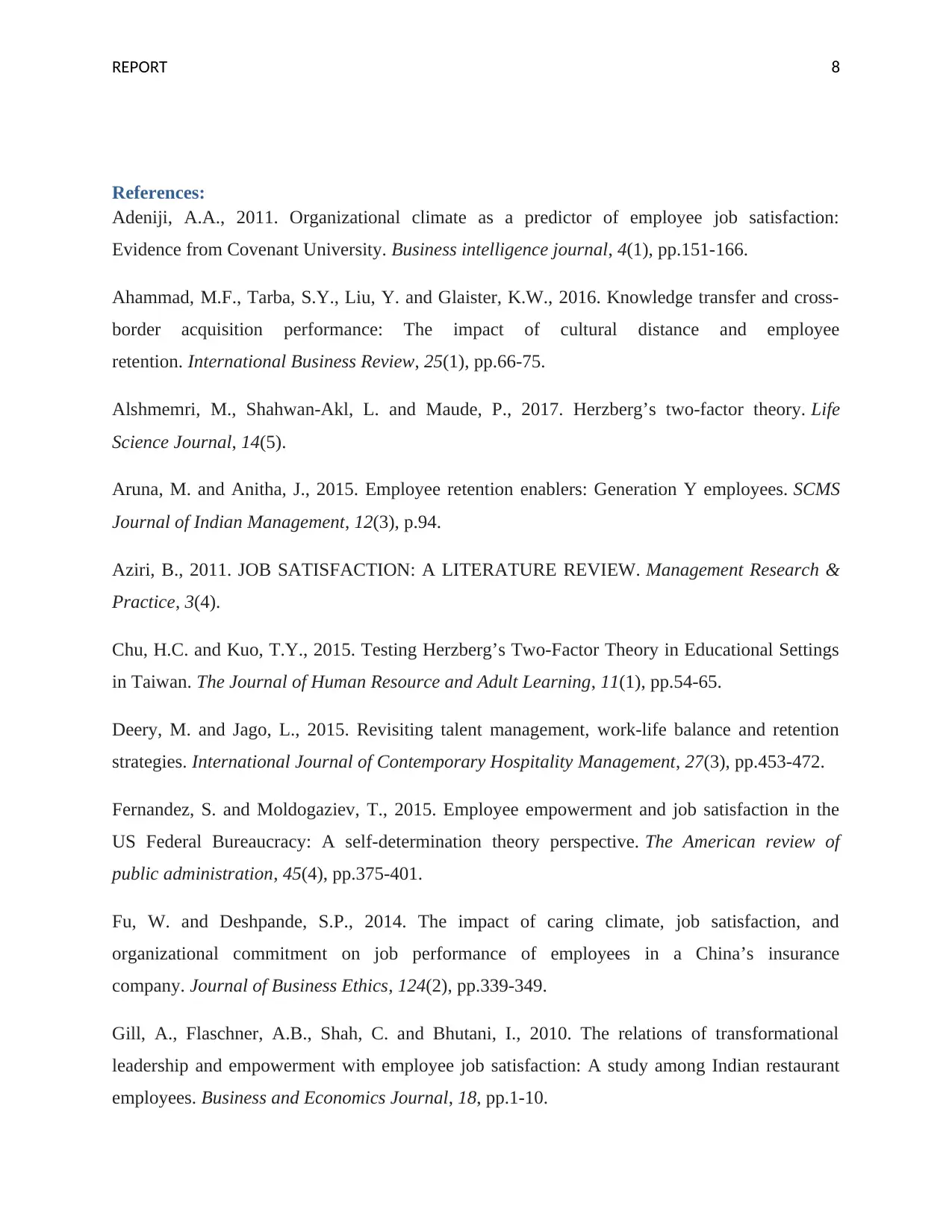
REPORT 8
References:
Adeniji, A.A., 2011. Organizational climate as a predictor of employee job satisfaction:
Evidence from Covenant University. Business intelligence journal, 4(1), pp.151-166.
Ahammad, M.F., Tarba, S.Y., Liu, Y. and Glaister, K.W., 2016. Knowledge transfer and cross-
border acquisition performance: The impact of cultural distance and employee
retention. International Business Review, 25(1), pp.66-75.
Alshmemri, M., Shahwan-Akl, L. and Maude, P., 2017. Herzberg’s two-factor theory. Life
Science Journal, 14(5).
Aruna, M. and Anitha, J., 2015. Employee retention enablers: Generation Y employees. SCMS
Journal of Indian Management, 12(3), p.94.
Aziri, B., 2011. JOB SATISFACTION: A LITERATURE REVIEW. Management Research &
Practice, 3(4).
Chu, H.C. and Kuo, T.Y., 2015. Testing Herzberg’s Two-Factor Theory in Educational Settings
in Taiwan. The Journal of Human Resource and Adult Learning, 11(1), pp.54-65.
Deery, M. and Jago, L., 2015. Revisiting talent management, work-life balance and retention
strategies. International Journal of Contemporary Hospitality Management, 27(3), pp.453-472.
Fernandez, S. and Moldogaziev, T., 2015. Employee empowerment and job satisfaction in the
US Federal Bureaucracy: A self-determination theory perspective. The American review of
public administration, 45(4), pp.375-401.
Fu, W. and Deshpande, S.P., 2014. The impact of caring climate, job satisfaction, and
organizational commitment on job performance of employees in a China’s insurance
company. Journal of Business Ethics, 124(2), pp.339-349.
Gill, A., Flaschner, A.B., Shah, C. and Bhutani, I., 2010. The relations of transformational
leadership and empowerment with employee job satisfaction: A study among Indian restaurant
employees. Business and Economics Journal, 18, pp.1-10.
References:
Adeniji, A.A., 2011. Organizational climate as a predictor of employee job satisfaction:
Evidence from Covenant University. Business intelligence journal, 4(1), pp.151-166.
Ahammad, M.F., Tarba, S.Y., Liu, Y. and Glaister, K.W., 2016. Knowledge transfer and cross-
border acquisition performance: The impact of cultural distance and employee
retention. International Business Review, 25(1), pp.66-75.
Alshmemri, M., Shahwan-Akl, L. and Maude, P., 2017. Herzberg’s two-factor theory. Life
Science Journal, 14(5).
Aruna, M. and Anitha, J., 2015. Employee retention enablers: Generation Y employees. SCMS
Journal of Indian Management, 12(3), p.94.
Aziri, B., 2011. JOB SATISFACTION: A LITERATURE REVIEW. Management Research &
Practice, 3(4).
Chu, H.C. and Kuo, T.Y., 2015. Testing Herzberg’s Two-Factor Theory in Educational Settings
in Taiwan. The Journal of Human Resource and Adult Learning, 11(1), pp.54-65.
Deery, M. and Jago, L., 2015. Revisiting talent management, work-life balance and retention
strategies. International Journal of Contemporary Hospitality Management, 27(3), pp.453-472.
Fernandez, S. and Moldogaziev, T., 2015. Employee empowerment and job satisfaction in the
US Federal Bureaucracy: A self-determination theory perspective. The American review of
public administration, 45(4), pp.375-401.
Fu, W. and Deshpande, S.P., 2014. The impact of caring climate, job satisfaction, and
organizational commitment on job performance of employees in a China’s insurance
company. Journal of Business Ethics, 124(2), pp.339-349.
Gill, A., Flaschner, A.B., Shah, C. and Bhutani, I., 2010. The relations of transformational
leadership and empowerment with employee job satisfaction: A study among Indian restaurant
employees. Business and Economics Journal, 18, pp.1-10.
⊘ This is a preview!⊘
Do you want full access?
Subscribe today to unlock all pages.

Trusted by 1+ million students worldwide
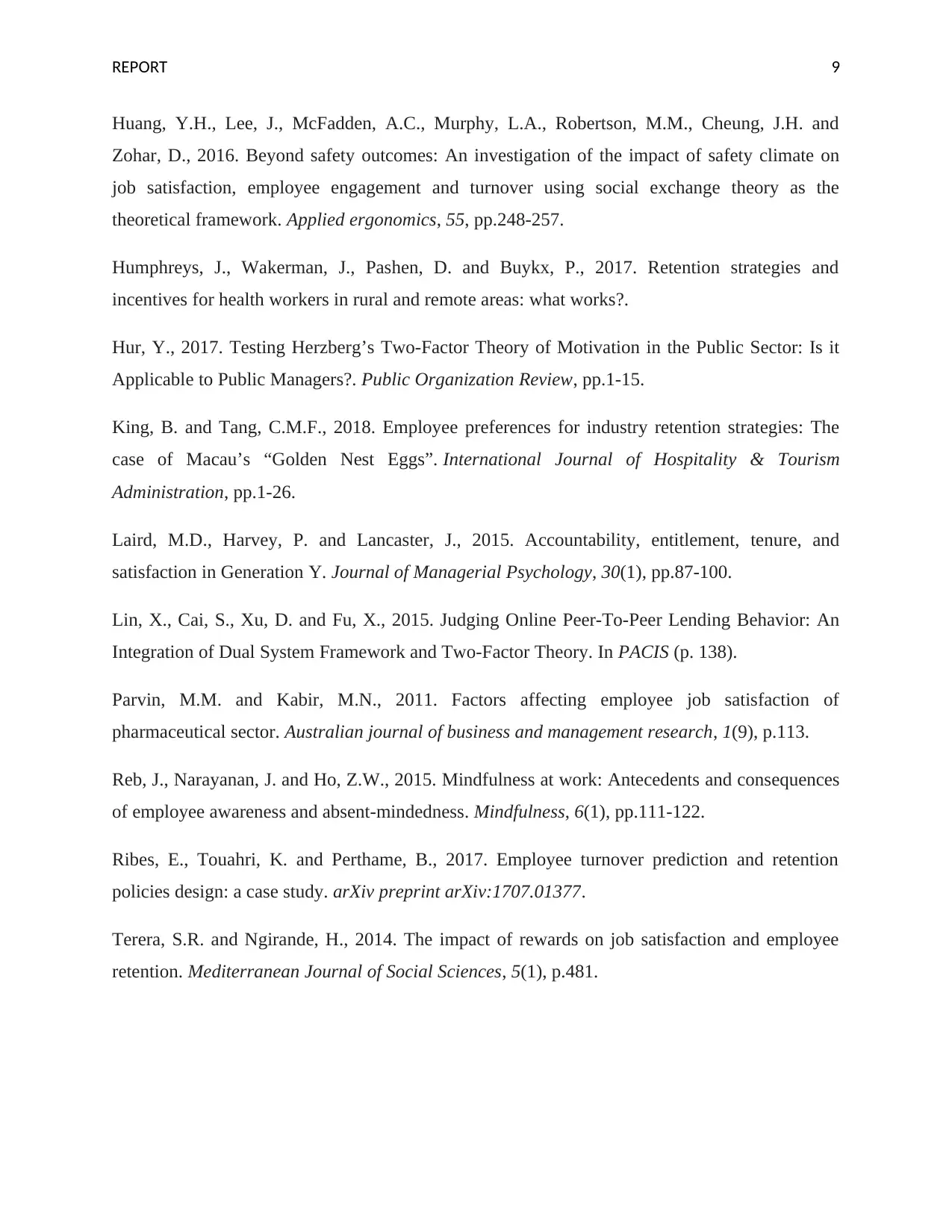
REPORT 9
Huang, Y.H., Lee, J., McFadden, A.C., Murphy, L.A., Robertson, M.M., Cheung, J.H. and
Zohar, D., 2016. Beyond safety outcomes: An investigation of the impact of safety climate on
job satisfaction, employee engagement and turnover using social exchange theory as the
theoretical framework. Applied ergonomics, 55, pp.248-257.
Humphreys, J., Wakerman, J., Pashen, D. and Buykx, P., 2017. Retention strategies and
incentives for health workers in rural and remote areas: what works?.
Hur, Y., 2017. Testing Herzberg’s Two-Factor Theory of Motivation in the Public Sector: Is it
Applicable to Public Managers?. Public Organization Review, pp.1-15.
King, B. and Tang, C.M.F., 2018. Employee preferences for industry retention strategies: The
case of Macau’s “Golden Nest Eggs”. International Journal of Hospitality & Tourism
Administration, pp.1-26.
Laird, M.D., Harvey, P. and Lancaster, J., 2015. Accountability, entitlement, tenure, and
satisfaction in Generation Y. Journal of Managerial Psychology, 30(1), pp.87-100.
Lin, X., Cai, S., Xu, D. and Fu, X., 2015. Judging Online Peer-To-Peer Lending Behavior: An
Integration of Dual System Framework and Two-Factor Theory. In PACIS (p. 138).
Parvin, M.M. and Kabir, M.N., 2011. Factors affecting employee job satisfaction of
pharmaceutical sector. Australian journal of business and management research, 1(9), p.113.
Reb, J., Narayanan, J. and Ho, Z.W., 2015. Mindfulness at work: Antecedents and consequences
of employee awareness and absent-mindedness. Mindfulness, 6(1), pp.111-122.
Ribes, E., Touahri, K. and Perthame, B., 2017. Employee turnover prediction and retention
policies design: a case study. arXiv preprint arXiv:1707.01377.
Terera, S.R. and Ngirande, H., 2014. The impact of rewards on job satisfaction and employee
retention. Mediterranean Journal of Social Sciences, 5(1), p.481.
Huang, Y.H., Lee, J., McFadden, A.C., Murphy, L.A., Robertson, M.M., Cheung, J.H. and
Zohar, D., 2016. Beyond safety outcomes: An investigation of the impact of safety climate on
job satisfaction, employee engagement and turnover using social exchange theory as the
theoretical framework. Applied ergonomics, 55, pp.248-257.
Humphreys, J., Wakerman, J., Pashen, D. and Buykx, P., 2017. Retention strategies and
incentives for health workers in rural and remote areas: what works?.
Hur, Y., 2017. Testing Herzberg’s Two-Factor Theory of Motivation in the Public Sector: Is it
Applicable to Public Managers?. Public Organization Review, pp.1-15.
King, B. and Tang, C.M.F., 2018. Employee preferences for industry retention strategies: The
case of Macau’s “Golden Nest Eggs”. International Journal of Hospitality & Tourism
Administration, pp.1-26.
Laird, M.D., Harvey, P. and Lancaster, J., 2015. Accountability, entitlement, tenure, and
satisfaction in Generation Y. Journal of Managerial Psychology, 30(1), pp.87-100.
Lin, X., Cai, S., Xu, D. and Fu, X., 2015. Judging Online Peer-To-Peer Lending Behavior: An
Integration of Dual System Framework and Two-Factor Theory. In PACIS (p. 138).
Parvin, M.M. and Kabir, M.N., 2011. Factors affecting employee job satisfaction of
pharmaceutical sector. Australian journal of business and management research, 1(9), p.113.
Reb, J., Narayanan, J. and Ho, Z.W., 2015. Mindfulness at work: Antecedents and consequences
of employee awareness and absent-mindedness. Mindfulness, 6(1), pp.111-122.
Ribes, E., Touahri, K. and Perthame, B., 2017. Employee turnover prediction and retention
policies design: a case study. arXiv preprint arXiv:1707.01377.
Terera, S.R. and Ngirande, H., 2014. The impact of rewards on job satisfaction and employee
retention. Mediterranean Journal of Social Sciences, 5(1), p.481.
1 out of 10
Related Documents
Your All-in-One AI-Powered Toolkit for Academic Success.
+13062052269
info@desklib.com
Available 24*7 on WhatsApp / Email
![[object Object]](/_next/static/media/star-bottom.7253800d.svg)
Unlock your academic potential
Copyright © 2020–2025 A2Z Services. All Rights Reserved. Developed and managed by ZUCOL.


